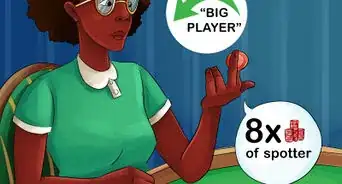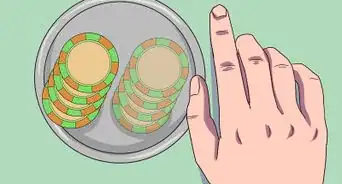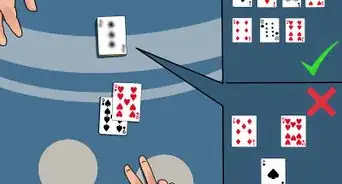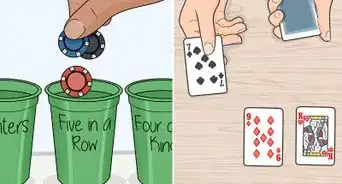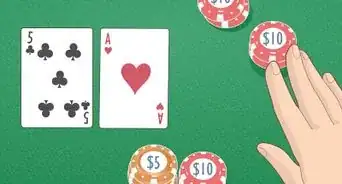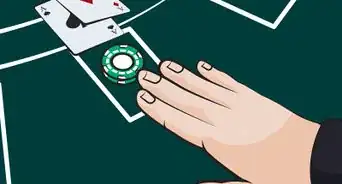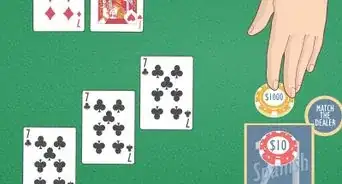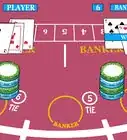This article was co-authored by wikiHow Staff. Our trained team of editors and researchers validate articles for accuracy and comprehensiveness. wikiHow's Content Management Team carefully monitors the work from our editorial staff to ensure that each article is backed by trusted research and meets our high quality standards.
There are 9 references cited in this article, which can be found at the bottom of the page.
This article has been viewed 134,919 times.
Learn more...
Casino, also known as “Cassino”, is a popular card game best played with 2-4 players. The object of the game is to capture cards from a layout of face-up cards on the table, but the process can be tricky, especially for beginners. Whether you’ve never played Casino or simply want to improve your technique, if you know the correct way to set up the game and make builds, you’ll be well on your way to capturing cards like a pro.
Steps
Setting Up the Game
-
1Play Casino with 2-4 players. Casino is best played with 2 people, but can be played with up to 4. The players always sit across from the dealer, unless they are playing in teams.[1]
- If 2 people are playing, the players sit directly across from one another.
- If 3 people are playing, 2 players sit across from the dealer. This seating arrangement should rotate every time the dealer changes.
- If 4 people are playing, split them into teams of 2 with each partner sitting across from the other.
-
2Remove the Jokers from a standard 52-card deck. Make sure the dealer shuffles the cards well before dealing. Have a player who did not shuffle cut the deck to mix up the cards even more.[2]
- To cut the deck, pick up roughly half of the cards from the top of the deck. Then, place that section underneath the other section, basically swapping the top half of the deck with the bottom half of the deck.
Advertisement -
3Deal 2 cards face-down to each player except the dealer. If there are 2 players, only the person opposite the dealer receives 2 cards at this point. If there are 3 or 4 players, start with the player sitting left of the dealer and move clockwise until all players except the dealer have 2 cards.[3]
- There is only 1 dealer, even when playing in teams.
- The cards dealt to you are your hand, so you may look at them. Do not show your cards to any other player.
-
4Place 2 cards face-up in the middle of the table. Deal the cards in a straight line where all of the players can see them. The object of Casino is to is to capture the face-up cards in the middle of the table.[4]
-
5Lay 2 cards face-down in front of the dealer. These cards will be part of the dealer’s hand, so the dealer can look at them. Do not show them to anyone else. Do not give cards to the dealer until the opposing players and the table have each received 2 cards.[5]
- The dealer will always be the last person to receive cards.
-
6Pass out 2 more cards face-down to every player, including the dealer. Repeat the process and deal 2 face-down cards to each player, followed by 2 face-up cards to the middle, and finally 2 face-down cards to the dealer. Each player, including the dealer will now have 4 cards, with 4 cards in the middle.[6]
- This method of dealing, called the “2-by-2” method, is the traditional way to deal Casino.
- You may also deal 1 card at a time if you prefer.
Capturing Cards on the Table
-
1Match cards in your hand to cards on the table on your turn. If you have a card in your hand that is the same value as a card on the table, play the card in your hand to capture the card on the table. Play the card from your hand on top of the matching card in the middle. Place captured cards face-down in a pile in front you. These will be used to count the score at the end of the game.[7]
- For example, if you have an 8 in your hand, you can capture an 8 on the table. If you have a 5 in your hand, you can capture a 5 on the table, and so on.
- After a capture, the turn passes clockwise to the next player.
-
2Win several cards at once by matching their combined values. Match up the cards on the table that you want to capture, then place the matching card in your hand on top of them. Place these cards face-down in the pile of captured cards in front of you.[8]
- For example, if you have a 7 in your hand, you can capture a 3 and 4, 5 and 2, or 6 and 1. If you have an 8, you can capture 2 4’s, a 3 and 5, a 2 and 6, or a 1 and 7.
- You can capture more than 2 cards if they add up to the matching number. For instance, if you have a 9 in your hand, and a 2, 3, and 4 on the table, you may capture all 3 cards on the table.
- Aces are counted as the number 1.
-
3Match face cards with other face cards of the same rank. Face cards may only be captured with other face cards and do not have a numerical value. You can only capture 1 face card at a time.[9]
- For instance, if you have a Queen (Q) in your hand, and there are 2 Q’s on the table, you may capture 1 of the Q’s, but not both.
-
4Combine and pair at the same time to capture even more cards. You may execute both of the above capturing methods if the cards on the table support the maneuver. For instance, if you have an 8 in your hand, and the table shows a 3, 5, and 8, you can combine the 3 and 5 and capture the matching 8 at the same time.[10]
-
5Earn extra points by capturing all the cards on the table. For instance, if you have a 10 in your hand, and an Ace, 2, 3, and 4 on the table, you may capture all 4 cards on the table at one time. Capturing all of the cards at once is called a “sweep” and scores you 1 additional point.[11]
- Place the capturing card face-up on top of the cards you captured and place them all in the pile of captured cards in front of you. The face-up card will indicate a sweep when you start to score your cards.
-
6Play a card to the table if you can’t capture anything. Choose a card from your hand and lay it face-up next to the other cards on the table. The card you played becomes one of the face-up cards in the middle of the table that other plays can now capture. This is called “trailing”.[12]
- You may also trail if you can capture a card, but would rather save it for making a build later on.
- You are allowed to trail a card even if that card could be used to capture.
- Following a sweep, a player can only trail.
-
7Deal 4 more cards to each player when someone runs out of cards. Do this throughout the course of the game until all of the reserve cards have been dealt. When dealing the last cards, the dealer must announce “last” to the other players.[13]
- All players receive 4 more cards, even if they currently have cards in their hand.
Creating Builds to Capture Cards
-
1Combine a card in your hand with a card on the table to create a build. To create a build, you must have a card in your hand that can later be used to capture the build. Place the card from your hand on top of and slightly lower than the card on the table, so that you can see the number on the bottom card. Then, declare the number you are building.[14]
- For instance, if you have a 6 and 8 in your hand, and a 2 on the table, you can lay the 6 on top of the 2 to create a build because you have an 8 that can be used to capture it. You would then declare, “building 8”.
- You cannot capture the build in the same turn it is created. If an opposing player has an 8 as well, they could capture the build on their next turn before you.
- If you have more than 1 of the same card value in your hand, you may want to combine them in a build to capture them all. For instance, if you have 2 5’s in your hand and there is a single 5 on the table, you can create a 5-build and capture all 3 5’s on your next turn instead of directly capturing a single 5.
-
2Use more than 2 cards to help make builds. If you don’t have all of the needed cards in your hand, you can combine cards on the table to add up to the build you desire. For instance, if there is an Ace, 2, and 3 on the table, and you have an Ace and 7 in your hand, you could combine those 3 cards on the table with your Ace to build a 7. On your next turn, you would capture all of those cards, unless another player has a 7 and captures them first.[15]
- Builds must include a card you just played, as they cannot be made up entirely of cards on the table.
-
3Combine 2 or more builds together to create a multiple build. Multiple builds are 2 or more combinations of the same card value. The person creating the multiple build must announce the value they are building. A player may capture a multiple build by playing a card of the same value as announced by the person making the build.[16]
- For instance, a multiple 5-build could be made of a 2 and 3 plus an Ace and 4. It could also be made of an Ace and 1 plus a 5, or multiple 5’s. When making the build, a player would say, “building 5”.
- All cards in a multiple build should be placed in the middle of the table on top of each other, with the value of each card visible.
- The value of a multiple build can never change. This makes multiple builds a safer play than single builds, because they are harder to steal.
-
4Capture a build by playing a card of the same rank. The player will announce what rank they are building when they make the build. For example, if the player combined a 2 and 4, they would say, “building 6”. A player must then play a 6 to capture the build.[17]
- On your turn, if the table contains a build which you created or added to yourself, you must make a capture of some sort, create a build, or add to a build. You cannot simply trail a card.
-
5Add cards to a single build if you have a card matching the total value. For example, say a player combines a 2 and 6 to make an 8-build. If you have an Ace and 9 in your hand, you can add the Ace to make a 9-build.[18]
- If you were the last player to add to a build, you must keep the capturing card in your hand to keep the play legal. You may not trail with the capturing card.
-
6Use cards on the table to add to a multiple build. For instance, say there is a 2, 5, and 10 on the table, and the 2 and 5 are combined into a 7-build. You hold a 3 and a 10. You can play your 3, combining it with the 7-build to make 10, and at the same time, incorporate the 10 on the table, turning it into a multiple 10-build.[19]
- The capturing number for a multiple build can never be changed. It will always remain the same value as declared by the person who created the build.
- You cannot use cards on the table to add to the value of a single build.
-
7Take in loose cards on the table that add up to the same number as the build. For example, you just made a 9-build and there is a 5 on the table. Your opponent plays a 4. On your next turn, you can take in the 5 and 4 at the same time you capture the 9-build.[20]
Scoring the Game
-
1Hand all remaining cards to the last player who made a capture. The game ends after all cards have been played after the final deal. The cards left on the table after all cards have been played are awarded to the last person to make a capture.[21]
- This is why it’s important for the dealer to announce “last” when dealing the last round of cards.
- These cards are sometimes called the “residue”.
-
2Award 3 points to the person with the most captured cards. Count each player’s stack of captured cards. If there is a tie for the most number of cards, no one receives points. Sort out the spades while you count.[22]
- Pull out any cards that are facing a different direction. This indicates a sweep, and each sweep earns the player an additional 1 point.
-
3Give 1 point to the person who captured the most spades. Count each player’s pile of spades. The player who captured the most spades gets 1 point. If there is a tie for most number of spades, no points are awarded.[23]
-
4Sort out the Aces, 10 of diamonds, and 2 of spades. Each captured Ace counts as 1 point. The 10 of diamonds is worth 2 points, while the 2 of spades is worth 1 point.[24]
- The 10 of diamonds is sometimes known as the “Big Casino” or “Good 10”.
- The 2 of spades is sometimes known as the “Little Casino” or “Good 2”.
-
5Play several rounds until a player reaches 21 or more points. If multiple players reach 21 on the same round, the player with the highest score wins the game. If there is a tie, then another round is played.[25]
- A player will usually reach 21 points in 2-4 rounds.
- After each round, the dealer passes the deck to the player on their left to deal the next hand.
Community Q&A
-
QuestionCan you lay down a pair that you are dealt?
 Community AnswerNo, since you can only play one card on each turn, so you would lay down one of the cards on one turn, and then make it a pair on your next turn if it's still there.
Community AnswerNo, since you can only play one card on each turn, so you would lay down one of the cards on one turn, and then make it a pair on your next turn if it's still there. -
QuestionWhat are the card games in Casino?
 Community Answer7-14-21, Card Craps, Card Sharks, Casino War, Catch a Wave, Faro, One for the Money, Red Dog, Screw Your Neighbor, Three Way Action, Trente Et Quarante, Triple Shot, Two Cards High, Vegas Three Card Rummy and Zero are the games.
Community Answer7-14-21, Card Craps, Card Sharks, Casino War, Catch a Wave, Faro, One for the Money, Red Dog, Screw Your Neighbor, Three Way Action, Trente Et Quarante, Triple Shot, Two Cards High, Vegas Three Card Rummy and Zero are the games. -
QuestionWhat are the points in casino card game?
 Drew Hawkins1Community AnswerIn the Casino card game, points aren't tallied up until the game actually ends. Once all of the cards have been played after the final deal, the cards on the table are awarded to the last person to make a capture. Then, you can start counting up the points. The person with the most captured cards gets 3 points. If there's a tie for the most number of cards, no one gets the points. Whoever captured the most spades gets 1 point. Each captured Ace counts as 1 point. The 10 of diamonds is worth 2 points, while the 2 of spades is worth 1 point. Additionally, any cards facing a different direction indicate a sweep, which are worth 1 point each. Keep playing rounds of Casino until 1 player reaches 21 or more points. If multiple players reach 21 on the same round, the player with the highest score wins the game.
Drew Hawkins1Community AnswerIn the Casino card game, points aren't tallied up until the game actually ends. Once all of the cards have been played after the final deal, the cards on the table are awarded to the last person to make a capture. Then, you can start counting up the points. The person with the most captured cards gets 3 points. If there's a tie for the most number of cards, no one gets the points. Whoever captured the most spades gets 1 point. Each captured Ace counts as 1 point. The 10 of diamonds is worth 2 points, while the 2 of spades is worth 1 point. Additionally, any cards facing a different direction indicate a sweep, which are worth 1 point each. Keep playing rounds of Casino until 1 player reaches 21 or more points. If multiple players reach 21 on the same round, the player with the highest score wins the game.
Things You’ll Need
- 52-card standard deck
- 2-4 players
- Pen and paper (for scoring)
References
- ↑ https://www.britannica.com/topic/casino-card-game
- ↑ https://www.pagat.com/fishing/casino.html
- ↑ https://www.pagat.com/fishing/casino.html
- ↑ https://www.pagat.com/fishing/casino.html
- ↑ https://youtu.be/WrdSVHMYocc?t=28
- ↑ https://www.pagat.com/fishing/casino.html
- ↑ https://www.pagat.com/fishing/casino.html
- ↑ https://youtu.be/WrdSVHMYocc?t=89
- ↑ http://www.spitenet.com/Cassino/play.htm
- ↑ https://considerable.com/casino/
- ↑ https://www.britannica.com/topic/casino-card-game
- ↑ https://youtu.be/WrdSVHMYocc?t=96
- ↑ https://www.pagat.com/fishing/casino.html
- ↑ http://www.spitenet.com/Cassino/play.htm
- ↑ https://www.pagat.com/fishing/casino.html
- ↑ http://psellos.com/cassino/rules.html
- ↑ https://www.pagat.com/fishing/casino.html
- ↑ https://www.pagat.com/fishing/casino.html
- ↑ https://www.pagat.com/fishing/casino.html
- ↑ https://www.pagat.com/fishing/casino.html
- ↑ https://www.pagat.com/fishing/casino.html
- ↑ https://www.britannica.com/topic/casino-card-game
- ↑ https://youtu.be/WrdSVHMYocc?t=44
- ↑ https://youtu.be/WrdSVHMYocc?t=44
- ↑ http://www.spitenet.com/Cassino/play.htm
- ↑ https://www.pagat.com/fishing/casino.html
About This Article
Casino is a popular 2-4 player card game where players try to capture cards on the table to score points. To play, first choose one player to be the dealer for the first round. The dealer deals 2 cards face down to each player except for themselves. Then they deal 2 cards face up in the middle of the table, followed by 2 cards face down to themselves. Finally, they deal 2 more cards face down to every player, including themselves, so everyone has 4 cards in total. The player to the left of the dealer goes first. On a player’s turn, they can capture a face-up card on the table if they have a card of the same rank in their hand. For example, if a player has an 8 in their hand and there is a face-up 8 on the table, they can capture the face-up card. After capturing a card, the player places both cards face down in front of them. A player can also capture multiple face-up cards if they add up to a number that matches one of the cards in their hand. For example, if a player has a 9 in their hand, they could capture a 4 and 5, a 7 and 2, or a 1, 3, and 5 since those cards add up to 9. A player can also use a single card in their hand for multiple captures in the same turn. For example, if they have an 8, they could use it to capture a face up 8 on the table as well as a face up 5 and 3. If a player captures all of the face-up cards on the table, it’s called a “sweep.” A sweep is worth 1 extra point. Once a player can’t capture any more cards, the player to their left goes next. If a player isn’t able to capture any cards on their turn, they play a card from their hand face up in the middle of the table. Whenever a player runs out of cards, 4 more cards are dealt to every player, including the dealer. Players can also make “builds” on their turn to help them capture cards later on. For example, a player can place a 6 from their hand on a face-up 2 so they’re overlapping to “build” an 8. Then, on their following turn, they could use an 8 from their hand to capture the 6 and 2 (unless another player captures them first). Players can’t capture builds on the same turn they play them. Players can also make a build by combining multiple face-up cards with a card from their hand. For example, a player could move a face-up 3 onto a face-up 5 and then place a 2 from their hand on those cards to build a 10. Players can also combine multiple builds on the table to make a bigger number, like by moving a 5 build onto a 4 build to build a 9. The game continues until all of the cards have been dealt out and played. The remaining face-up cards on the table go to the last player who made a capture as a bonus. Then, everyone tallies up their points. Each captured ace is worth 1 point. The 10 of diamonds is worth 2 points, and the 2 of spades is worth 1 point. Whoever captured the most cards gets 3 points. Whoever captured the most spades gets 1 point. After each round, the deal passes to the next player on the left, and a new round starts. The first player to get 21 or more points wins the game! To learn how to create builds to capture cards, keep reading!
-Step-1-Version-2.webp)
-Step-2-Version-2.webp)
-Step-3-Version-2.webp)
-Step-4-Version-2.webp)
-Step-5.webp)
-Step-6.webp)
-Step-7.webp)
-Step-8.webp)
-Step-9.webp)
-Step-10.webp)
-Step-11.webp)
-Step-12.webp)
-Step-13.webp)
-Step-14.webp)
-Step-15.webp)
-Step-16.webp)
-Step-17.webp)
-Step-18.webp)
-Step-19.webp)
-Step-20.webp)
-Step-21.webp)
-Step-22.webp)
-Step-23.webp)
-Step-24.webp)
-Step-25.webp)


